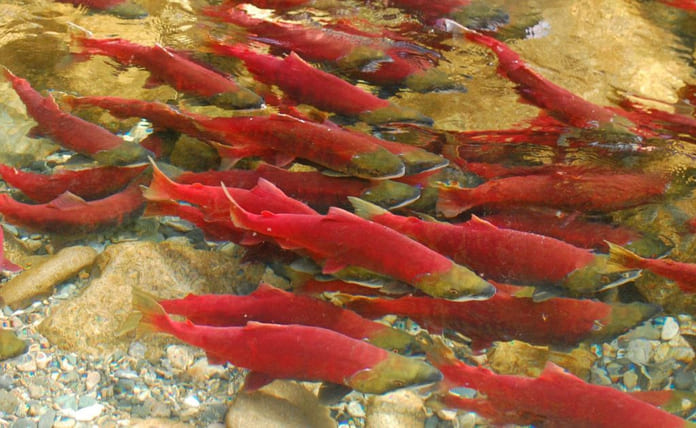Respiratory performance of wild Pacific sockeye salmon functions normally even when infected with piscine orthoreovirus (PRV).
According to a new study, PRV poses a very low risk to British Columbia’s population of wild Pacific salmon.
Wild salmon
Researchers at the University of British Columbia (UBC), Fisheries and Oceans Canada (DFO) and the Ministry of Agriculture, Food and Fisheries published their findings in biology journal BMC Biology.

The nine-week study found no physiological differences between PRV-infected fish and a control group, injected with a salt solution. The study used sockeye salmon to test the respiratory impacts of wild salmon because they migrate near salmon farms.
“We saw little to no effect on sockeye salmon’s respiratory fitness after PRV-infection and minimal impacts on their ability to sustain the vigorous activity needed to migrate, catch prey and avoid predators,” said Dr. Yangfan Zhang, a post-doctoral researcher in UBC’s faculty of land and food systems and the department of zoology, and the joint lead author of the study.
Very low risk
The UBC researchers worked with scientists from the BC Ministry of Agriculture, Food and Fisheries, and Fisheries and Oceans Canada—which funded the study—with collaborative support from the BC Salmon Farmers Association (BCSFA) who did not participate in the study design, data collection, and analysis, preparation of the manuscript, or decision to publish.
“This means PRV poses a very low risk to British Columbia’s population of wild Pacific salmon,” Dr. Zhang said.
“The findings highlight that not all animal viruses cause notable harm during infection,” said joint lead author and DFO researcher Dr. Mark Polinski.

“This is the first study to show that sockeye salmon can be a carrier of PRV without untoward physiological effects to their respiratory system,” says Dr. Tony Farrell, a professor and Canada Research Chair with UBC’s faculty of land and food systems and the department of zoology, and one of the principal investigators on the study.
The research team ran their experiment on a total of 400 sockeye salmon at the DFO Pacific Biological Station in Nanaimo, BC.
Without a major metabolic cost
“The experimental PRV infection of sockeye salmon shows that the virus had no substantial impact on their oxygen use during maximum exercise, or when oxygen is low,” Dr. Farrell said
“Pacific and Atlantic salmon can resist a PRV infection without a major metabolic cost,” he says, addressing those concerned about the untested impacts of PRV on wild sockeye salmon,” he added.


